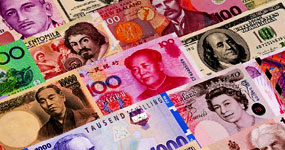
围绕中国是否将调整其盯住汇率机制的争论,已经演变为对于“何时”以及“如何”调整的狂热预期。自2008年7月以来,中国一直将人民币兑美元汇率保持在6.83元附近,以帮助本国出口商在全球贸易大幅下挫的环境中生存下来。
现在,随着越来越多的证据表明全球经济正稳步复苏——同时美国政界要求中国允许人民币升值的呼声——中美两国官员都一直在为调整汇率政策做准备。
就“何时”调整而言,美国财长蒂姆•盖特纳(Timothy Geithner)访问北京,以及他决定推迟向国会提交是否把中国列为汇率操纵国的报告,提升了人们的预期。
谈到“如何”调整,中国2005年的举措被视为一种可能的模式。当时在汇改的第一天,人民币兑美元汇率上涨2.1%,随后人民币兑美元汇率被允许在指定区间内交易。
对于其它货币,这将意味着什么?巴克莱资本(Barclays Capital)指出,2005年汇改第一天出现了许多其它的变动。在7月20日至21日之间,韩元兑美元汇率上涨2.5%,日元、新加坡元和新台币兑美元汇率均走高。然而,一周之后,大多数货币都回吐了涨幅。
在对华出口比例较高的国家,这些效应一直存在,这有其道理。人民币升值会降低中国进口商品的价格。布朗兄弟哈里曼银行(Brown Brothers Harriman)估计,2005年7月之后的6个月,新加坡元、韩元、新台币和日元与人民币的联动性最强。
短期而言,明显的赢家将是正确把握时机的外汇交易员。更长期而言,有望获得外汇收益的将是以中国为最大出口市场的亚洲经济体:台湾、菲律宾、韩国和新加坡。
译者/君悦
http://www.ftchinese.com/story/001032123

The debate about whether China will shift its pegged currency regime has turned into frenzied speculation about “when” and “how”. China has kept the renminbi at around 6.83 per dollar since July 2008 as it sought to help its exporters survive the dramatic nosedive in global trade.
Now, as there is growing evidence that the global economy is making a steady recovery – and as political calls in the US get louder for China to let its currency appreciate – both Chinese and US officials have been preparing the ground for a shift.
In terms of “when”, the visit of US Treasury secretary Tim Geithner to Beijing – and his decision to delay a report to Congress on whether to label China as a currency manipulator – has raised expectations.
In terms of “how”, China's moves in 2005 are seen as a likely model. Then, the currency rose 2.1 per cent against the dollar on the first day, after which it was allowed to trade within a set range.
What would this mean for other currencies? Barclays Capital notes there were plenty of other moves on day one in 2005. Between July 20 and July 21, the South Korean won jumped 2.5 per cent against the dollar, with the yen, Singapore and Taiwan dollars also rising. A week later, however, most of the gains had reversed.
The effects persisted in countries with a large export share going to China. That makes sense. Chinese appreciation makes goods from other countries cheaper to import. Brown Brothers Harriman calculates the correlation with the renminbi for the six months after July 2005 was highest for the Singapore dollar, the Korean won, Taiwan dollar and yen.
In the short term, the obvious winners will be currency traders who get their timing right. Longer term, look for currency gains in Asian countries for which China is the top export market: Taiwan, Philippines, Korea and Singapore.
没有评论:
发表评论